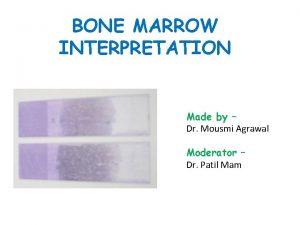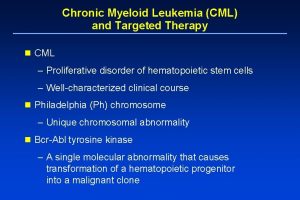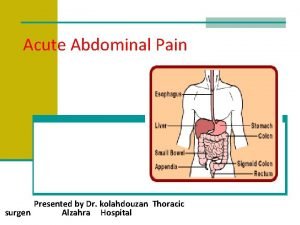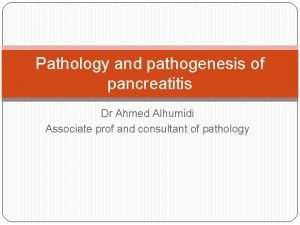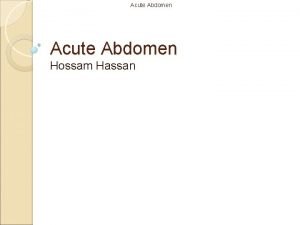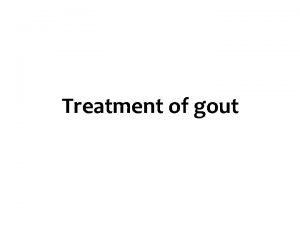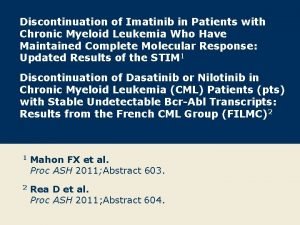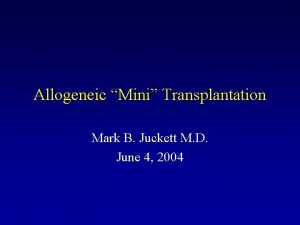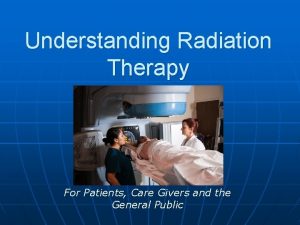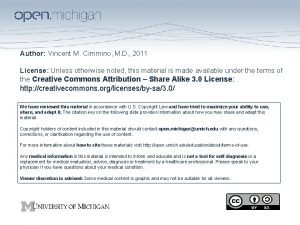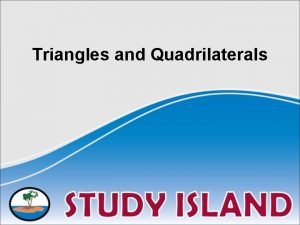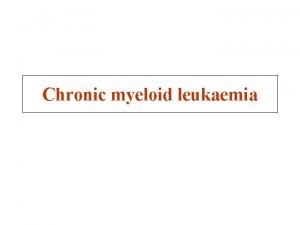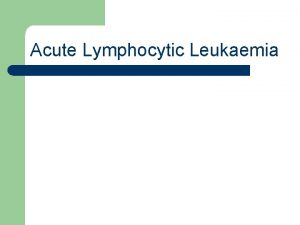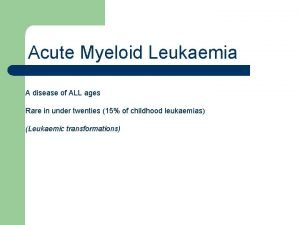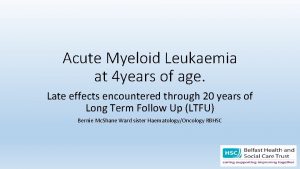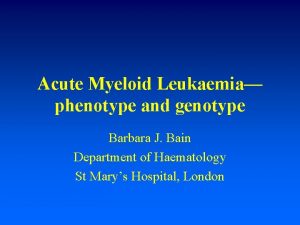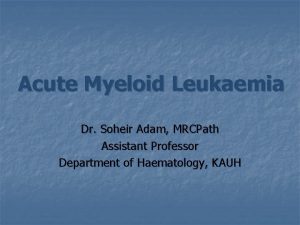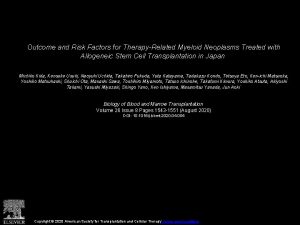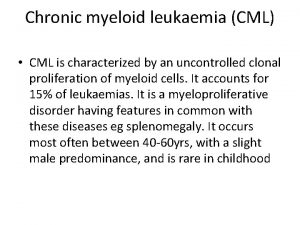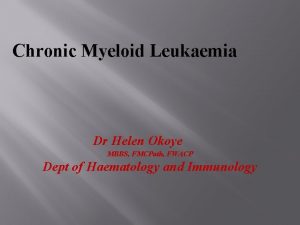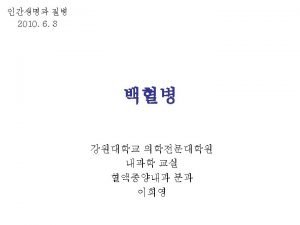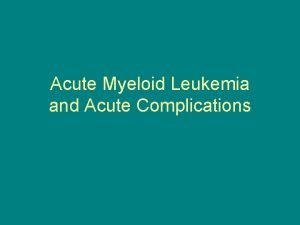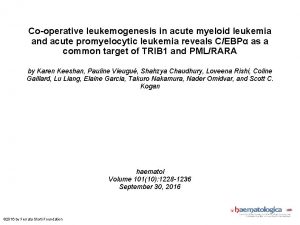Therapyrelated acute myeloid leukaemia following treatment for cancer















- Slides: 15

Therapy-related acute myeloid leukaemia following treatment for cancer in childhood: a population-based registry study Joanne Aitken, Danny Youlden, Cate Brown, Andy Moore Cancer Council Queensland Children’s Hospital

Background • t-AML occurs in patients exposed to cytotoxic chemotherapy and/or radiotherapy • Rare disease with a poor prognosis • Most of what is known about t-AML comes from studies of adult cancer

Data • Australian Childhood Cancer Registry • Includes all children (<15 yrs) diagnosed with cancer in Australia • Annual matching against the Australian Cancer Database (for later cancers) and the National Death Index • Treatment details are collected for first and subsequent cancers diagnosed <15 years of age

Eligibility criteria • First primary cancer other than AML • First diagnosis between 1983 and 2012 • Treated with chemotherapy and/or radiotherapy (with start date of treatment recorded)

Determination of t-AML • First and second cancers for the same patient were matched using a unique registry number • Any subsequent AML was assumed to be t-AML (after initiation of treatment for the first cancer)

Time at risk • Follow-up for second diagnosis available to Dec 31, 2014. • Time at risk was calculated from date of first treatment until either: - end of the study period - date of death - date of diagnosis of t-AML • Maximum age at end of follow-up = 46 years

Analysis • Standardised incidence ratios (SIRs) calculated to measure relative risk of t-AML • Observed survival from date of diagnosis of t-AML estimated using Kaplan-Meier method • Key variables of interest: - sex - age group - period of diagnosis - type of first cancer - treatment received (<15 years old)

Study cohort • 58 (0. 5%) of 11, 753 eligible patients were diagnosed with t-AML • Two-thirds were males; almost half aged 0 -4 yrs at first diagnosis • 78% t-AML cases diagnosed within 5 years of first cancer • 76% t-AML cases aged <15 yrs at diagnosis of t-AML, none diagnosed after age 24 yrs • Only 8 cases of t-AML had correct morphology code (M 99203) • 98% of t-AML patients had chemotherapy, 34% had also had radiotherapy

Relative risk of t-AML Characteristic n SIR (95% CI) TOTAL 58 45. 6 (35. 3 -59. 0) Male 39 52. 7 (38. 5 -72. 1) Female 19 35. 7 (22. 8 -56. 0) Blood cancer 29 40. 8 (28. 3 -58. 7) Solid tumours 29 51. 7 (36. 0 -74. 5) Chemotherapy 57 49. 0 (37. 8 -63. 6) Radiotherapy 20 41. 2 (26. 6 -63. 9) 7 120. 7 (57. 5 -253. 2) First cancer Treatment for first cancer HSCT

Treatment for t-AML • t-AML treatment details were available for 44 children diagnosed <15 years • 75% received chemotherapy plus either HSCT (48%) or radiotherapy (11%) • Of the 40 patients where remission status was recorded, complete remission was achieved for: - 95% of 21 with HSCT 21% of 19 without HSCT

Survival following t-AML • 71% of the 58 t-AML patients had died by 31 Dec 2104 • Five-year observed survival was 31. 2% (95% CI = 19. 6%-43. 5%) • No significant differences in survival by: - sex (although maybe males worse) - age at t-AML diagnosis - year of t-AML diagnosis - time from first to second diagnosis - type of first cancer

Survival following t-AML by HSCT Five-year observed survival: p < 0. 001 • HSCT = 52. 4% (29. 7%-70. 9%) • No HSCT = 5. 7% (0. 4%-22. 6%)

Conclusions • t-AML is an important late effect of childhood cancer treatment (accounts for 17% of second primary cancers following childhood cancer in Australia) • Imprecision in coding may hinder research into t-AML • Male predominance combined with possible survival disadvantage – further investigation warranted • Patients should be prepared for HSCT as soon as possible after diagnosis with t-AML

Want to know more? Brown CA, Youlden DR, Aitken JF, Moore AS. Pediatr Blood Cancer. 2018; 65: e 27410

Thank you and questions?
 Aspiration biopsy
Aspiration biopsy Treatment of cml
Treatment of cml Expektans
Expektans Parietal pain
Parietal pain Pathophysiology of acute pancreatitis
Pathophysiology of acute pancreatitis Hydropic gallbladder
Hydropic gallbladder Acute abdomen treatment
Acute abdomen treatment Gout treatment
Gout treatment Chronic myeloid leukemia
Chronic myeloid leukemia Chronic myeloid leukemia
Chronic myeloid leukemia Myeloid tissue
Myeloid tissue Mark juckett md
Mark juckett md Myeloid metaplasia
Myeloid metaplasia Radiation therapy side effects
Radiation therapy side effects Treatment of inflammatory breast cancer
Treatment of inflammatory breast cancer Classifying triangles and quadrilaterals
Classifying triangles and quadrilaterals
